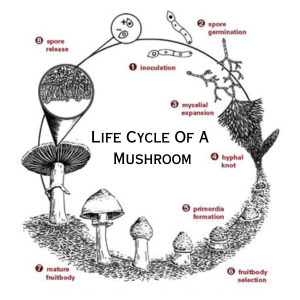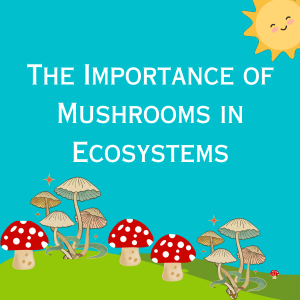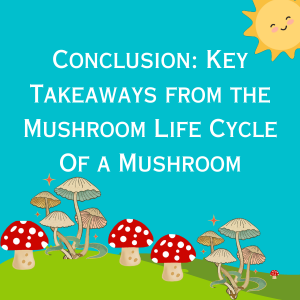Life Cycle Of Mushroom
Introduction to Mushrooms

Mushrooms, fascinating and often misunderstood, are fungi distinguished by their unique growth patterns, captivating shapes, and diverse applications, from culinary uses to ecological functions. They come in thousands of species, each with unique characteristics and life cycles. But what process transforms a tiny, almost invisible spore into the mushroom we recognize? This article will look at the different stages in a mushroom’s life. Understanding the Mushroom Life CycleTo fully grasp the life cycle of a mushroom, it’s essential to understand that what we commonly identify as a ‘mushroom’ is the fruiting body of a much larger, primarily underground organism. This organism’s purpose is to produce spores, which can be likened to a plant’s seeds, to ensure the continuation of the species. The life cycle of a mushroom involves several stages:
- Spore formation and dispersion
- Germination into mycelium
- The growth of the hyphae into a mature, fruiting mushroom
Each of these phases is critical and involves intricate biological processes.
Spore Formation and Dispersion
The life cycle of a mushroom begins with spore formation. These spores are produced on the gills, pores, or other spore-producing areas on the underside of the mushroom cap. When conditions are right – typically in a damp, nutrient-rich environment – the mature mushroom releases these microscopic spores into the air. Due to their minute size and lightness, spores have the potential to travel extensive distances when carried by wind currents, allowing the mushroom to colonize new territories. The sheer number of spores produced by a single mushroom (potentially billions) increases the odds that at least some will land in a suitable environment to grow.
Germination: The Birth of Mycelium Upon
A mushroom’s life cycle begins with a spore. If the environment is right, the spore starts to grow. It takes in water from around it and creates a tube-like part called a hypha. When many hyphae grow and branch out, they form a web called mycelium. This mycelium is the main body of the mushroom and can live a long time. It can cover big areas under the ground. The mycelium eats by breaking down stuff in the soil and taking in the nutrients.
Next, the mushroom continues to grow. This is when the mycelium spreads within its food source like wood or soil. It eats the nutrients and grows. This stage is important as the mycelium is getting stronger. During this time, the mycelium forms a dense network of hyphae.
When the temperature, moisture, and nutrients are just right, the mushroom grows. From the mycelium, special structures called primordia form. If conditions are right, they grow into the mushroom that we recognize. This starts the next phase of the mushroom’s life cycle.
The life cycle of a mushroom is an amazing journey. It shows how nature can adapt, survive, and grow. By understanding these stages, we can appreciate these incredible organisms. We also see the important role they play in our ecosystems.
Maturation: The Role of the Primordia
Once the mycelium has established itself and is robust enough, the maturation process begins, signaled by primordia formation. These are small, knobby structures from which the mushroom’s fruiting bodies will grow. It’s interesting to note that various factors influence primordia creation, including temperature, humidity, and light levels. Once formed, the primordia will develop into a fully mature mushroom, given the appropriate environmental conditions.
Fruiting Bodies: The Emergence of Mature Mushrooms
The fruiting body of a mushroom is the part we typically recognize. These structures can take various shapes and sizes, from the familiar umbrella-shaped cap and stalk to more unusual forms like cups, shelves, and puffballs. Regardless of their shape, all fruiting bodies serve the same purpose: to produce and disperse spores, ensuring the continuation of the species.
The development of the fruiting body is a fascinating process. From the tiny primordia, the mushroom grows rapidly, drawing nutrients from the mycelium network. Once it has reached full size, the mushroom is ready to release its spores and complete its life cycle. Click here to read our other articles.
How Mushrooms Reproduce

Mushrooms reproduce by releasing spores equivalent to seeds in the plant kingdom. The spores are produced in the mushroom’s fruiting body and released into the environment upon maturity. Some mushrooms eject their spores forcefully, while others rely on external forces like wind or animal interaction for dispersion.
Each spore has the potential to germinate into new mycelium and start the life cycle all over again. However, the spore must land in a suitable environment with sufficient moisture and nutrients for successful germination.
External Factors Affecting Mushroom Growth
The mushroom’s growth, like most organisms, is significantly affected by its environment. Key external factors influencing mushroom development include temperature, humidity, light levels, and the availability of food sources.
Temperature and humidity often play critical roles in triggering mushrooms to form fruiting bodies. Most mushrooms prefer cool, damp environments, varying depending on the species. Light levels can also influence mushroom growth, with some species requiring light to form fruiting bodies, while others can grow in complete darkness.
The type and availability of food sources are also critical. Most mushrooms feed on decaying organic matter, breaking down dead plants and animals into simpler components that other organisms can use. This process is crucial in maintaining the health of ecosystems by recycling nutrients.
Environmental Impact and the Mushroom Life Cycle
Mushrooms play a vital role in the environment, and their life cycle is inherently tied to the ecosystems’ health. Breaking down organic matter contributes to nutrient cycling and soil formation, key components of healthy, productive ecosystems.
Furthermore, some species form symbiotic relationships with plants, assisting in nutrient absorption and improving plant health. These relationships highlight the interconnectivity of nature and the integral role mushrooms play within it.
The life cycle of a mushroom, from spore to mature fruiting body, is a testament to nature’s ingenuity and resilience. Understanding this process helps us see how these often ignored organisms are really important in keeping our planet healthy.
The Importance of Mushrooms in Ecosystems

Mushrooms serve several crucial roles in ecosystems. They decompose, breaking down dead organic material and turning it into nutrients other organisms can use. They are also essential in the soil formation process. Without fungi, dead organic matter would accumulate, and nutrient cycles would be interrupted.
Moreover, some mushrooms form mutualistic relationships with plants through mycorrhizal associations, where the mushroom’s mycelium connects with the plant’s roots. This symbiotic relationship enhances the plant’s nutrient absorption, promoting its growth and health. Through these relationships, mushrooms help sustain forest ecosystems and contribute to biodiversity.
The Uniqueness of the Mushroom Life Cycle
The mushroom life cycle is unique among organisms. Unlike plants that grow from seeds, mushrooms develop from microscopic spores, forming a network of mycelium before producing the fruiting bodies we recognize as mushrooms.
Additionally, many mushroom species can reproduce sexually and asexually, adding another layer of complexity to their life cycle. The mushroom’s ability to disperse spores over long distances, its resilience in various environmental conditions, and its crucial role in nutrient recycling all contribute to the distinctiveness of the mushroom life cycle.
Frequently Asked Questions about Mushroom Growth
- Do all mushrooms grow from spores? Yes, all mushrooms begin their life cycle as spores.
- Can mushrooms grow in the dark? While some mushrooms require light to develop fruiting bodies, others can grow in darkness.
- How fast do mushrooms grow? The growth rate of mushrooms varies among species. Some can fully develop within a day or two, while others may take weeks or months.
- Can the same mycelium produce multiple mushrooms? Yes, a single mycelium network can produce multiple fruiting bodies, often in response to environmental changes such as rainfall or temperature shifts.
Conclusion: Key Takeaways from the Mushroom Life Cycle Of a Mushroom

The life cycle of a mushroom is a fascinating journey, from a tiny, invisible spore to a mature mushroom that releases billions of new spores into the environment. This cycle is an incredible example of nature’s resilience and creativity, demonstrating the crucial role of mushrooms in our ecosystems, nutrient cycles, and even in symbiotic relationships with other organisms.
Understanding this process gives us a deeper appreciation of these often-underestimated organisms. We also come to understand the deep connections between all living things in our ecosystems and how every organism, no matter its size or apparent importance, holds a key role in maintaining nature’s balance.
References and Further Reading
- Money, N. P. (2011). Mushroom. Oxford University Press.
- Volk, T. J., & Leonard, T. J. (1990). Cytology of the life-cycle of Pholiota nameko. Mycological Research, 94(3), 399-406.
- Watling, R., & Harper, D. B. (1998). Chloromycetin—a decade of development. Biological Reviews, 73(3), 221-243.
